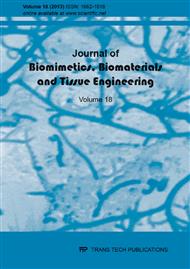[1]
M.P. Duckworth: Motor Vehicle Collisions Medical, Psychosocial, and Legal Consequences(Academic Press, USA 2008).
Google Scholar
[2]
S.W. Zhou: Journal of Biomimetics, Biomaterials and Tissue Engineering Vol. 9 (2001), pp.69-80
Google Scholar
[3]
M.J. van der Horst: Human head neck response in frontal, lateral and rear end impact loading modelling and validation(Ph.D. Dissertation, Eindhoven University of Technology 2002).
Google Scholar
[4]
A.M. Pearson: Spine Vol. 30 (2005), pp.1852-1858
Google Scholar
[5]
M.M. Panjabi: Spine Vol. 29 (2004), pp.2395-2403
Google Scholar
[6]
P.C. Ivancic: Spine Vol. 32 (2007), pp.2467-2473
Google Scholar
[7]
V. Esat: IUTAM Proceedings on Impact Biomechanics: From Fundamental Insights to Applications Vol. 2005 (2005), pp.91-100[8] S. Himmetoglu: Proceedings of the Institution of Mechanical Engineers, Part D: Journal of Automobile Engineering Vol. 221 (2007), pp.527-541
Google Scholar
[9]
L.X. Guo: Computers in Biology and Medicine Vol. 38 (2008), pp.146-151
Google Scholar
[10]
Z.P. Li: Annals of Biomedical Engineering Vol. 34 (2006), pp.1452-1462
Google Scholar
[11]
Y. Kitagawa: Traffic Injury Prevention Vol. 9 (2008), pp.574-582
Google Scholar
[12]
K. Yuichi: Stapp Car Crash Journal Vol. 50 (2006), pp.545-566
Google Scholar
[13]
N. Yoganandan: Journal of Biomechanical Engineering Vol. 122 (2000), pp.623-629
Google Scholar
[14]
N. Yoganandan: Annals of Biomedical Engineering Vol. 36 (2008), pp.406-414
Google Scholar
[15]
N. Yoganandan: Traffic Injury Prevention Vol. 10 (2009), pp.51-57
Google Scholar
[16]
B.D. Stemper: Medical and Biological Engineering and Computing Vol. 42 (2004), pp.333-338
Google Scholar
[17]
W. Hell: Traffic Injury Prevention Vol. 3 (2002), pp.127-140
Google Scholar
[18]
J. Latchford: Proceedings of the Institution of Mechanical Engineers, Part D: Journal of automobile engineering Vol. 219 (2005), pp.1293-1302
Google Scholar
[19]
M.M. Panjabi: Traffic Injury Prevention Vol. 6 (2005), pp.387-397
Google Scholar
[20]
P.C. Ivancic: Traffic Injury Prevention Vol. 6 (2005), pp.175-184
Google Scholar
[21]
M.M. Panjabi: Spine Vol. 31 (2006), pp.420-429
Google Scholar
[22]
J. Maher: Accident Analysis and Prevention Vol. 32 (2000), pp.299-305
Google Scholar


